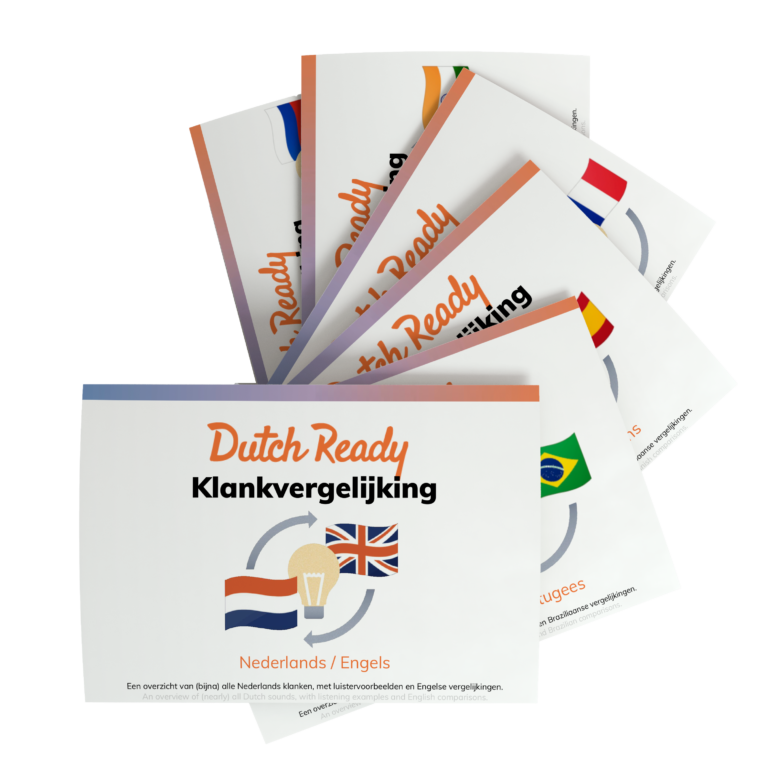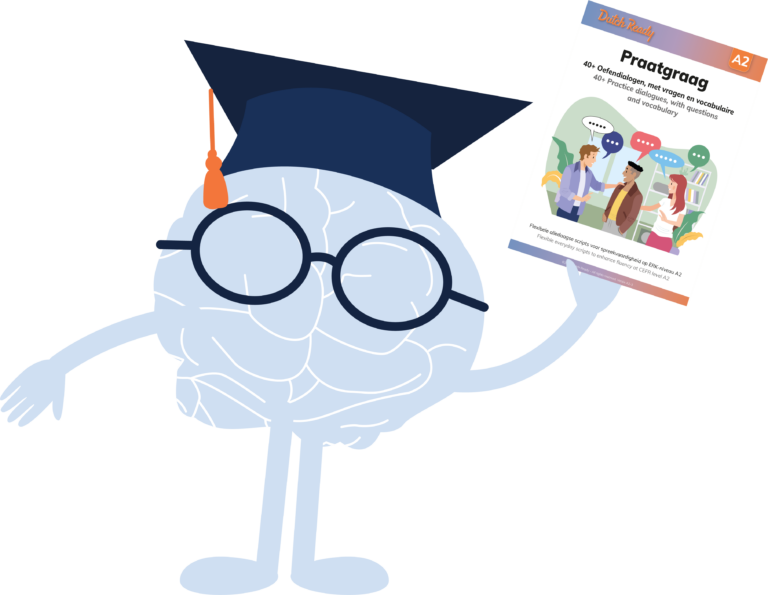

“You’re in a store, ready to ask the question in Dutch that you’ve practiced so many times. But then it happens: a sudden mental block. The fear of messing up feels overwhelming. In the end, you leave the store with the whole grain bread you needed, but without the positive experience you had hoped for. You switched back to English, or communicated in a language that you believe most resembled spoken stenography. Now what?”
Living in the Netherlands can be an incredible experience, but if you’re an expat who’s still learning the language, it might feel like a rollercoaster of excitement and anxiety. Being afraid to speak Dutch can affect your confidence, cultural integration, and social interactions. Whether you’re nervous about mispronouncing words, unsure of grammar, or afraid of raised eyebrows as soon as you open your mouth, you’re not alone. Many expats share this same fear of speaking Dutch.
In this blog, we’ll explore why many expats are afraid to speak Dutch, and, most importantly, provide you with some of the most practical solutions to overcome your fear. Because, as with everything, fear really is your very worst advisor.
At Dutch Ready, we’ve been teaching Dutch for years. Trust us, fear of speaking Dutch is something that a large part of our students deals with at some point during their learning journey. These are some of the most common fears we have heard:

Remember: all of the fears above are completely normal and part of the learning process. Of course, that doesn’t take away the fact that you would prefer to get rid of it as soon as possible. We’ll discuss how to do that in the rest of this blog:
When a student says they’re afraid to speak Dutch, they most often mean they’re afraid to make mistakes when speaking Dutch. But what if we told you that each mistake is actually valuable? Speaking Dutch requires trial and error, just as anything else you learn that’s new. Adopting an approach where you see mistakes as learning opportunities reflects a growth mindset: you focus on improvement rather than perfection.
When you’re afraid to speak Dutch, it’s also good to know that being fluent in a language doesn’t mean being error-free. Instead, it’s about being able to express yourself and being understood. Even native speakers sometimes make mistakes or cannot come up with a word. That does not diminish the fact that they are fluent in the language.
Speaking ability (what most people would label fluency) actually consists of two key aspects:
Many learners set the bar too high and focus too much, or even exclusively, on accuracy. But what really matters in the end is getting your message across.
Create a list of your ‘success moments’ to remind yourself of progress. For example, did you have a short conversation at the market, even if it wasn’t perfect? Celebrate it! Ordered ‘1 kilo rood appels’ instead of ‘1 kilo rode appels?’ The world is not going to end and the vendor won’t hold it against you. They are just happy to see you as a customer at their stall!

Do you find it exciting to apply your Dutch in everyday conversations? Our advice: challenge yourself, but never push yourself to your limits when you are really dreading it immensely. After all, learning a language cannot be successful if all you experience is stress. Fortunately, you have more than enough options to practice speaking Dutch. Below, we listed a few:
Although pronunciation plays a crucial role in speaking (and speaking confidence), the influence of pronunciation on overall speaking skills is often underestimated. Have you ever heard someone say ‘Beginners need to focus on grammar’? If so, what they probably mean is that beginners shouldn’t assume a one-to-one correspondence between languages. Of course, they should pay attention to things such as how sentences are constructed coherently in the target language. But that doesn’t mean grammar should be studied at the expense of everything else.
Learning the correct pronunciation of words will ensure that others can understand you. Even if your grammar isn’t perfect, native speakers will still grasp what you’re saying. The more feedback you receive on your pronunciation, the more your skills will improve.
To illustrate, take for example the student who mastered Dutch word order and built up a large vocabulary in a short time. He paid far less attention to his pronunciation, though. This became painfully clear when one day he said:
‘Ik moet mijn hoer betalen’ (I need to pay my prostitute), while he actually meant:
‘Ik moet mijn huur betalen’ (I need to pay my rent).
Long story short: first focus on pronunciation, then on grammar. You’ll also notice that less Dutchies switch to English during conversations when your pronunciation is right.

Linguistic similarities between languages can significantly improve your ability to master pronunciation, and incorporating knowledge of your native language can make language learning more effective. That does not only apply to pronunciation, but to all other aspects of the language as well. If you’ve read any of our blogs before (or if you might even take Dutch classes with us) you know that your native language is one of the key features of our approach. To specifically help you with Dutch pronunciation, we developed the free downloadable Sound Comparison Cards in 15 different languages: English, French, German, Spanish, Italian, Polish, Russian, Hindi, Portuguese, Danish, Hungarian, Korean, Mandarin, South-African, and Turkish.
Click here to go directly to the download page and to receive the Sound Comparison Card especially developed for your native tongue.
For learners who are afraid to speak Dutch and want more in-depth pronunciation support, our Sound Module provides detailed explanations of tricky sounds, such as the g/ch sound and diphthongs. The module includes audio examples to mimic correct sounds, step-by-step explanation on Dutch pronunciation by a speech therapist, and practical exercises to reinforce what you have learned. Want to give it a try? Access the free demo of our Sound Module and discover four free lessons, including an introduction. The lessons you will have access to are: the alphabet, the long aa sound, the aai sound, and open & closed syllables.
Did you take swimming lessons as a child? Think back to the first time in the pool. Were you just thrown into the deep end by the instructor? Or, were you given floaties and allowed to slowly go down the steps, and with each step a bit deeper into the water? We assume (and sincerely hope) that the second was the case. When you’re afraid to speak Dutch, use the same approach. Start out easy and gradually build your confidence.

Systematic desensitization, which is a common therapy in psychology applied to fears, among other things, is also effective with learners who are afraid to speak Dutch. With systematic desensitization, you first deal with the situations you find least frightening. If that goes well and you build up confidence, and you move on to the next situation. According to science, speech training with systematic desensitization enhances students’ speaking competence. The graduated exposure part is something you can try to apply yourself. An exposure list could, for example, look like this (number one is the least frightening situation, number 6 is the most difficult situation):
Of course, this is just an example. Your list can be as long as you want it to be and contain every kind of speaking situation you feel you need to practice with.
Dutch Ready’s Praatgraag A1 and A2 dialogue bundles are especially designed to help you practice your speaking abilities. Each bundle contains 20 chapters with 2-3 dialogues each. The fill-in-the-blank options help you with improvisation in real-life conversations and with the help of the vocabulary list that accompanies each chapter, you’ll easily expand your vocabulary on all kinds of daily subjects as well. You can practice alone, with fellow learners, or with native speakers who can offer feedback and help you improve.

Excited to get yourself prepared for real-life conversations? Visit our Dutch Ready shop for the Praatgraag A1 bundle, the Praatgraag A2 bundle, or the Praatgraag A1-A2 bundle for an extra favorable price.
Rather try it out first? No problem! Visit the free materials section on our website to download a demo without any obligation PLUS find out right away what other free Dutch learning materials we have for you!
When you’re learning a new language, it’s normal to have moments of hesitation. You might forget a word now and then, or overthink the sentence structure. Understanding why this happens and knowing how to manage these situations can significantly reduce your fear of speaking Dutch.
Relax and make life a little less hard on yourself! Do you ever notice a native speaker freeze when they can’t recall the right word? Probably not. So why should you? Of course, that doesn’t mean you want the conversation to suddenly stop. These strategies might come in handy:

Stressing out whenever things don’t go the way you planned isn’t of any help. What also isn’t? Overthinking. Contrary to what you might think, it can lead to more pauses and mistakes, and thus frustration. Overthinking goes hand in hand with not wanting to make mistakes, and thus not practicing, which ultimately means you’ll (almost) never actually apply newly learned things. Here are some strategies that might work:
How convenient would it be if you would just wake up one day and be able to speak Dutch? Unfortunately, we all know that only happens in fairy tales. Speaking Dutch fluently is an ongoing process that requires regular practice. Every (small) conversation or practice session counts. Hopefully the tips you read in this article are of help to you.
Are you afraid to speak Dutch? With the right support, it doesn’t have to be that daunting! Taking Dutch lessons with a tutor provides a safe, encouraging space to practice speaking without judgment. Your tutor tailors the lessons to your pace and interests, helping you build confidence step by step. Mistakes become learning moments, not setbacks. By receiving personalized feedback and real-time guidance, you’ll develop the skills you need to express yourself naturally and fluently. Whether you’re just starting or looking to improve, your tutor will help you break through the fear and start speaking Dutch with ease!

Learning and speaking Dutch becomes even easier when you do it together with a tutor with whom you actually have a match. That’s why at Dutch Ready you are never paired with just anyone. Instead, we take the time for an intake interview with you and based on that interview we suggest a tutor for a trial lesson. Does that person feel right? Then you’ve found your tutor and can get started! Book your trial lesson Dutch with Dutch Ready today to get yourself from afraid to speak Dutch to eager to speak the language!
Language lessons & materials designed to help you learn Dutch fast. Use what you know, simplify what you don’t.

Hi! We just wanted to let you know that we use cookies on our site. These cookies enhance your experience, improve the quality of our site, and help us show you things that are more likely to be relevant to you. You have the option to manually allow third parties (including our advertising partners) to enable cookies on our website. By clicking 'Accept', you're agreeing to the placement and use of cookies described in our Cookie Policy. That's all. Thanks for reading!